
Interface para codificador incremental
Codificadores incrementais garantem feedback consistente de velocidade e distância, mantendo a simplicidade do sistema e a rentabilidade. Estão disponíveis em uma ampla gama de opções e incluem uma interface de programação para maximizar a versatilidade. Apesar do tamanho compacto de 36 mm de diâmetro, os codificadores incrementais da POSITAL oferecem resolução de até 16.384 pulsos. Com classificação IP69K e resistência a choques de 300 g, os modelos com carcaça de aço inoxidável proporcionam proteção superior contra poeira, umidade e óleo.
Codificadores rotativos incrementais geram um sinal de saída cada vez que o eixo gira um determinado ângulo. O número de pulsos por rotação define a resolução do dispositivo. Como não fornecem posição absoluta, seu design interno é mais simples e econômico. Além do rastreamento de posição, são frequentemente usados para medir velocidade. A posição em relação ao ponto de partida pode ser determinada contando os pulsos, e a velocidade é calculada dividindo-se os pulsos pelo intervalo de tempo medido.
Princípio básico: codificador incremental
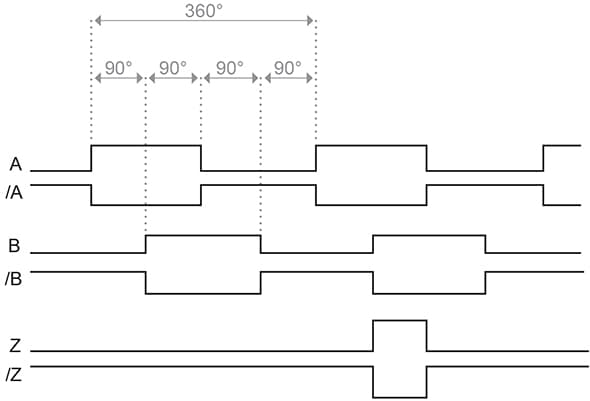
Codificadores rotativos incrementais fornecem um sinal de saída serial por uma única linha de transmissão. Um sensor deve estar conectado a um único controlador.
Um codificador incremental possui pelo menos um sinal de saída “A”, e geralmente dois sinais, “A” e “B”, com defasagem de 90° entre eles para detecção do sentido de rotação. Ao girar no sentido horário, o sinal “A” sobe 90° antes do “B”; no sentido anti-horário, o “B” sobe antes do “A”.
Alguns codificadores também geram um sinal “Z”, que ocorre uma vez por rotação, por cerca de 90°, sempre na mesma posição – útil como ponto de referência.
Há modelos com sinais diferenciais adicionais “/A”, “/B” e “/Z”, que são as versões invertidas de “A”, “B” e “Z”. O controlador pode comparar cada par de sinais para verificar erros na transmissão.
A utilização de cabo de par trançado melhora a integridade do sinal e a imunidade contra ruídos durante a transmissão.
Drivers de saída
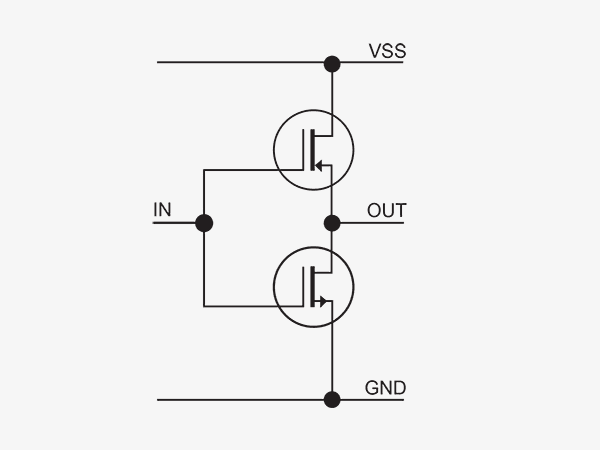
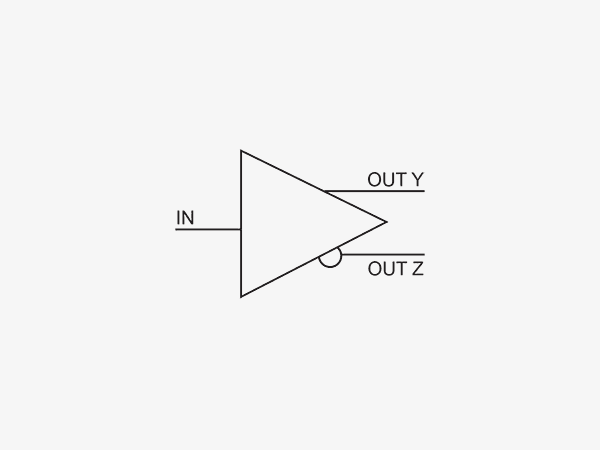
Push-Pull (HTL)
Circuitos Push-Pull (HTL), também conhecidos como Totem Pole, fornecem um nível de sinal correspondente à tensão de alimentação aplicada, normalmente entre 8 e 30 VDC. Com conexões adequadas, é possível usar a interface Push-Pull para substituir circuitos de coletor aberto verdadeiros, utilizando um diodo externo para limitar a direção da corrente.
RS422 (TTL)
Os circuitos RS422 (TTL) fornecem um nível de sinal constante de 5 V, independente da tensão de alimentação. É possível selecionar duas faixas de alimentação: de 4,75 a 5,5 VDC (pode substituir saídas do tipo coletor aberto) ou de 8 a 30 VDC. Com sinais diferenciais, a saída está totalmente em conformidade com o padrão RS422. As saídas diferenciais oferecem a maior resposta de frequência e a melhor imunidade a ruído. Para garantir isso, o receptor também deve ser diferencial.
Substituição de drivers de saída antigos
Substituição do coletor aberto PNP (fonte de corrente) | Substituição do coletor aberto NPN (sumidouro de corrente)
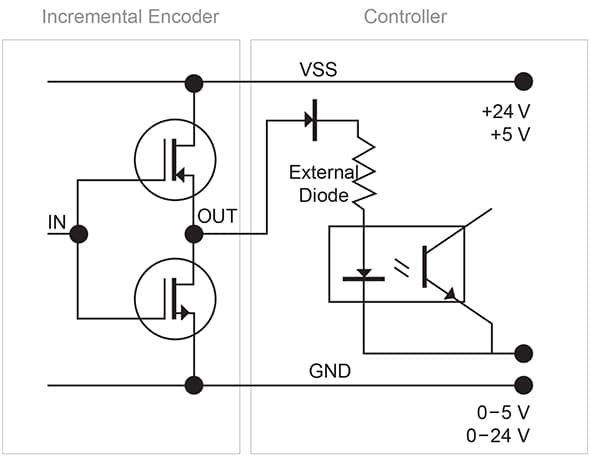
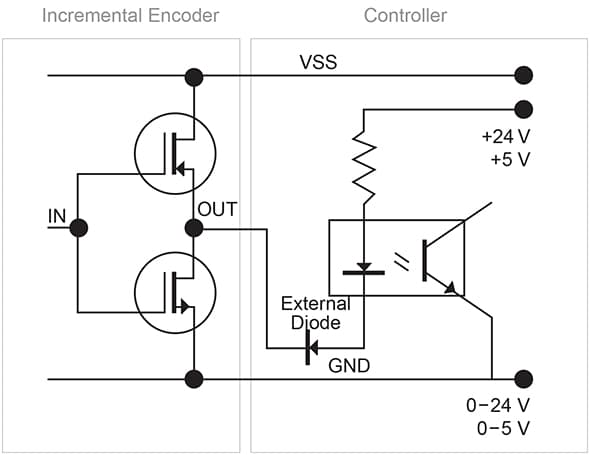
Programmable Incremental Encoder
Codificadores incrementais não programáveis só podem ser configurados na fábrica conforme as especificações do cliente. No entanto, se os requisitos da aplicação mudarem, um codificador incremental programável permite ajustar facilmente algumas características importantes. Com um software e uma ferramenta externa (UBIFAST Configuration Tool), é possível modificar:
Driver de saída incremental: Push-Pull (HTL) ou RS422 (TTL)
Pulsos por rotação (PPR): valor programável
Direção dos pulsos: “A antes de B” ou “B antes de A”
A programabilidade é especialmente vantajosa para distribuidores, integradores de sistemas e fabricantes de máquinas, pois reduz a necessidade de manter um grande estoque – um número reduzido de modelos padrão pode ser adaptado conforme necessário.
Especificações técnicas
Lógica | Nível de sinal | Tensão de alimentação | Tensão de saída |
|---|---|---|---|
TTL | Alto | 4.75-30 V | mínimo 3 V |
TTL | Baixo | 4.75-30 V | máximo 0,5 V |
HTL | Alto | 4.75-9 V 9-30 V | mínimo 3 V |
HTL | Low | 4.75-30 V | máximo 0,5 V |
Níveis de saída de tensão
Uma porta lógica interpreta certas tensões de entrada como nível alto (lógico 1) ou baixo (lógico 0).
TTL (lógica transistor-transistor): Sinais acima de 2 V são interpretados como lógicos 1 e abaixo de 0,8 V como lógicos 0. A saída varia de 0 a 5 V.
HTL (lógica de limiar alto): Sinais acima de 3 V são lógicos 1 e abaixo de 1 V são lógicos 0. O nível alto depende da tensão de alimentação. A lógica HTL oferece melhor imunidade a interferências e ruído elétrico.
Ângulo elétrico e mecânico
O ângulo mecânico é a rotação real do eixo em graus. O ângulo elétrico é utilizado para sinais elétricos. Um ciclo completo de tensão/corrente alternada é definido como 360 graus elétricos (el°). Para codificadores incrementais, um ciclo equivale a um pulso completo. Ao definir os pulsos por rotação (PPR), é possível converter o ângulo elétrico em ângulo mecânico para cada codificador incremental.
Ciclo de trabalho (Duty Cycle)
O ciclo de trabalho descreve a proporção entre o tempo “alto” e o tempo “baixo” de um codificador incremental. Normalmente, essa proporção é de 50/50, equivalente a 180 el° alto e 180 el° baixo.
O desempenho dos codificadores incrementais magnéticos melhora com configurações mais altas de PPR e maiores velocidades de rotação (RPM). O oposto ocorre com codificadores ópticos, cujo desempenho tende a diminuir. Os valores de DNL e INL indicados em nossas fichas técnicas representam o pior cenário; melhor desempenho é esperado com PPR e RPM mais altos.
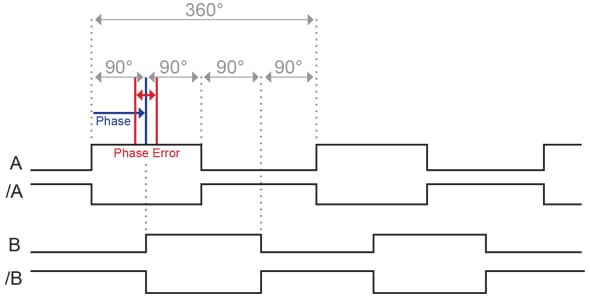
Quadratura
A cada 90 graus elétricos (el°), o codificador incremental gera uma borda de subida ou descida na saída “A” ou “B”, interpretada como mudança de sinal. Se o codificador estiver configurado para 1000 PPR, o contador registrará 4000 mudanças de sinal (4 por pulso).
Ângulo de fase
O ângulo de fase indica a distância entre duas bordas de sinal, em graus elétricos (el°). Este parâmetro é geralmente especificado com um valor constante e um erro de fase (também chamado de erro de quadratura).
Precisão (DNL)
A precisão DNL é o erro do ângulo de fase expresso como valor absoluto em graus mecânicos.
Resposta de frequência
É a frequência máxima que o codificador pode emitir pelas linhas de saída. Por exemplo, um codificador de 200 PPR a 600 RPM gera uma frequência de 2000 Hz (200 × 600 ÷ 60 s).
Precisão (INL)
Um codificador incremental gera uma quantidade definida de pulsos por rotação, com cada pulso correspondendo a uma posição mecânica específica. A maior diferença entre essa posição ideal e a posição real é chamada de não linearidade integral (INL). A precisão INL é especialmente importante quando o codificador é usado para tarefas de posicionamento.


